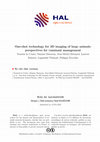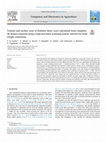Papers by Yannick Le Cozler

Although 2-dimensional (2D) imaging technology has shown its value, there is growing interest in ... more Although 2-dimensional (2D) imaging technology has shown its value, there is growing interest in the use of 3-dimensional (3D) imaging technology on farms. Indeed, it makes it possible to safely determine or estimate the most interesting morphological characteristics of living animals, to estimate their live weight or other parameters of interest such as their volume, their surface area or even, their chemical composition. The device called Deffilait3D is based on depth camera technology and it makes possible to overcome the negative effects of the direct light or the movements of animals. The values obtained on Holstein animals showed that the values generated for most of the measured indicators were precise, repeatable and reproducible. The live weight can be estimated with a good precision. A derivative of this device is currently being tested on commercial farms. The aim is now to finalize the automatization of image extraction and analysis methods, to enable the use of these tools on a large scale in commercial farms. TEASER TEXT Thanks to 3D-imaging based on one-shot technology; it is possible to determine morphological traits, body weight, surface or volume of dairy cows. The upcoming automation of measurements opens up prospects for high-throughput applications and analyzes on-farms.

Computers and Electronics in Agriculture, Oct 1, 2019
Three-dimensional (3D) imaging is a solution for monitoring morphology and growth of dairy cows, ... more Three-dimensional (3D) imaging is a solution for monitoring morphology and growth of dairy cows, but it can also estimate indicators such as body volume, surface area and body weight. A 3D full-body scanning device was used to scan 64 lactating Holstein cows from March-June 2018. The cows were individually and automatically weighed at a static weighing station (mean ± standard deviation = 673 ± 65 kg). These measured weights were compared to those predicted from regression models based on volume, area or morphological traits determined from 177 3D images. Since some images were truncated due to cow movement or technical problems, we developed additional regression models to reconstruct total volume or area. The accuracy of volume and area measurements was first tested on an inert cylindrical form (coefficients of variation (CVs) < 0.72%). The CVs for repeatability and reproducibility of the method of calculating volume and area from truncated images were 0.17% and 3.12%, respectively. Cow volume and area ranged from 0.61 to 0.96 m 3 and 5.80 to 8.32 m 2 respectively. Five regression models were developed to estimate cow body weight. Their coefficients of determination ranged from 0.82 to 0.93 with prediction errors of ca. 3% (20 kg) and 4% (29 kg) as a function of volume and area, respectively. The device and the method, evaluated and validated in this study, offer the possibility to use new indicators such as body volume and area in precision livestock farming.
HAL (Le Centre pour la Communication Scientifique Directe), Aug 26, 2019
HAL (Le Centre pour la Communication Scientifique Directe), Dec 7, 2022
HAL is a multidisciplinary open access archive for the deposit and dissemination of scientific re... more HAL is a multidisciplinary open access archive for the deposit and dissemination of scientific research documents, whether they are published or not. The documents may come from teaching and research institutions in France or abroad, or from public or private research centers. L'archive ouverte pluridisciplinaire HAL, est destinée au dépôt et à la diffusion de documents scientifiques de niveau recherche, publiés ou non, émanant des établissements d'enseignement et de recherche français ou étrangers, des laboratoires publics ou privés.
HAL (Le Centre pour la Communication Scientifique Directe), Jun 3, 2012

International audienceThe objective was to test 8 methods for estimation of empty body lipid (EBL... more International audienceThe objective was to test 8 methods for estimation of empty body lipid (EBL) and protein (EBP) mass in dairygoats. The methods tested on 20 Alpine goats (3±0.6 years old; 226±9 DIM; 47 to 72 kg of BW) were: adipose cellsize; deuterium oxide dilution space (D2OS); 3-dimension (3D) imaging: whole body 3D-scan and automatic 3Dassessment of body condition score (3D-BCS); manual sternal and lumbar BCS and ultrasound imagery; computer tomography and bioelectrical impedance spectroscopy (BIS). Simple and multiple regressions (Proc GLM, SAS) were tested between different variables and EBL and EBP mass measured by chemical analyses after slaughter. Perirenal adipose tissue mass and cell diameter combined with BW provided the most accurate predictive equations for EBL (R2=0.95, residual coefficient of variation, rCV=12%). Nonetheless, such predictors can only be measured postmortem. The best equations for EBL derived from in vivo variables included BW combined with 1/ the volume of fatty tissues measured by computer tomography (R2=0.92, rCV=17%), 2/ the D2OS (R2=0.91, rCV=19%), and 3/ the BIS (R2=0.87, rCV=23%). D2OS combined with BW provided the best equation for EBP (R2=0.97, rCV=3%), whereas BW alone provided a fair EBP estimate (R2=0.92, rCV=4%). Manual BCS combined with BW provided good EBL and EBP estimations (R2=0.80 and 0.94, rCV=28 and 4%, respectively). BCS is a non-invasive technique and does not require particular equipment, but it is subjective and prone to operator bias. Compared to manual BCS, 3D-BCS combined with BW slightly decreased the accuracy of the predictive equation for EBL (R2=0.74, rCV=32%), and did not improve the estimation of EBP compared with BW alone. Ultrasound and whole body 3D imaging techniques were not satisfactory estimators of EBL and EBP (R2≤0.40)
HAL (Le Centre pour la Communication Scientifique Directe), Dec 2, 2020
HAL (Le Centre pour la Communication Scientifique Directe), Dec 2, 2020
HAL (Le Centre pour la Communication Scientifique Directe), Dec 2, 2020
HAL (Le Centre pour la Communication Scientifique Directe), Jul 12, 2021

HAL (Le Centre pour la Communication Scientifique Directe), May 21, 2014
L’objectif de cette etude etait de savoir si l’evaluation de la teneur en Immunoglobulines G (IgG... more L’objectif de cette etude etait de savoir si l’evaluation de la teneur en Immunoglobulines G (IgG) du colostrum chez la vache laitiere Prim’Holstein etait differente selon qu’elle se realisait sur un echantillon de lait composite des quatre quartiers issus de la premiere traite (pratique courante), sur le lait issu d’un seul quartier ou a plusieurs moment de la premiere traite. Pour ce faire, la teneur en IgG a ete mesuree par immuno-diffusion radiale (IDR) a la fois sur un echantillon preleve de la premiere traite des 4 quartiers (lait composite) et a la fois sur un echantillon des autres quartiers et ce sur 78 vaches. De plus, 9 vaches ont fait l’objet de 7 a 9 prelevements en cours de premiere traite afin d’evaluer un effet potentiel « moment du prelevement ». Il ressort qu’au seuil de 50g/L pour considerer un colostrum de « bonne qualite » ou du moins de qualite acceptable, il n’y avait aucune influence ni du moment de prelevement ni du type de prelevement sur la mesure de la teneur en IgG. Compte-tenu de la capacite de buvee des veaux observee dans l’etude, il peut etre recommande de donner entre 2 et 4 litres dans les 2 premieres heures de vie du veau, le colostrum pouvant etre collecte preferentiellement des quartiers posterieurs. La quantite administree est cruciale comptetenu de la qualite des colostrums de vaches laitieres.
HAL (Le Centre pour la Communication Scientifique Directe), Dec 2, 2020
HAL is a multidisciplinary open access archive for the deposit and dissemination of scientific re... more HAL is a multidisciplinary open access archive for the deposit and dissemination of scientific research documents, whether they are published or not. The documents may come from teaching and research institutions in France or abroad, or from public or private research centers. L'archive ouverte pluridisciplinaire HAL, est destinée au dépôt et à la diffusion de documents scientifiques de niveau recherche, publiés ou non, émanant des établissements d'enseignement et de recherche français ou étrangers, des laboratoires publics ou privés.
Sensors, Jun 19, 2022
This article is an open access article distributed under the terms and conditions of the Creative... more This article is an open access article distributed under the terms and conditions of the Creative Commons Attribution (CC BY
HAL (Le Centre pour la Communication Scientifique Directe), May 18, 2022
HAL (Le Centre pour la Communication Scientifique Directe), Aug 30, 2021
HAL (Le Centre pour la Communication Scientifique Directe), Aug 30, 2021
HAL (Le Centre pour la Communication Scientifique Directe), 2018
HAL is a multidisciplinary open access archive for the deposit and dissemination of scientific re... more HAL is a multidisciplinary open access archive for the deposit and dissemination of scientific research documents, whether they are published or not. The documents may come from teaching and research institutions in France or abroad, or from public or private research centers. L'archive ouverte pluridisciplinaire HAL, est destinée au dépôt et à la diffusion de documents scientifiques de niveau recherche, publiés ou non, émanant des établissements d'enseignement et de recherche français ou étrangers, des laboratoires publics ou privés.










Uploads
Papers by Yannick Le Cozler